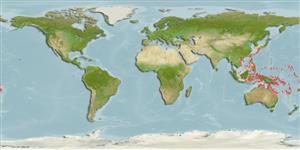>
Blenniiformes (Blennies) >
Tripterygiidae (Triplefin blennies) > Tripterygiinae
Etymology: Helcogramma: Greek, helkos, -eos, -ous = ulcer, sore + Greek, gramma = letter, mark (Ref. 45335).
More on author: Bleeker.
Environment: milieu / climate zone / depth range / distribution range
Sinh thái học
Biển Cùng sống ở rạn san hô; Mức độ sâu 0 - 6 m (Ref. 58018). Tropical
Western Pacific: East Andaman Sea (Thailand), Malaysia (Tioman Island), Indonesia (Belitung, Komodo, Halmahera, and Banda Sea), Philippines (Luzon), Papua New Guinea (wewak), Solomon Islands, Vanuatu, and Taiwan.
Bộ gần gũi / Khối lượng (Trọng lượng) / Age
Maturity: Lm ? range ? - ? cm
Max length : 4.5 cm SL con đực/không giới tính; (Ref. 559)
Short description
Khóa để định loại | Hình thái học | Sinh trắc học
Các tia vây lưng cứng (tổng cộng) : 16 - 18; Các vây lưng mềm (tổng cộng) : 8 - 11; Tia cứng vây hậu môn: 1; Tia mềm vây hậu môn: 16 - 19. Trunk without longitudinal stripes; symphyseal dentary pores 3 or more; lateral line with fewer than 25 scales; anal fin with fewer than 19 rays; male with bluish white stripe from corner of jaw onto preopercle (Ref. 94457). Additional description: Dorsal fin III + XIII-XV + 8-11; anal fin I, 16-19; pectoral rays 16-17; pelvic fin I,2. Lateral line continuous, pored scales 21-29; head and narrow strip on upper back scaleless, nape with only a few scales. Mandibular sensory pores 3-8 + 3-9 + 3-8 (usually 3+3+3). Male greyish green, head ventrally black, cheek with blue horizontal stripe; body vertical bars H-shaped, brownish; zone between pectoral fin and operculum greenish grey. Female overall translucent, head marks brown, H-bars faint, fins translucent (Ref. 90102).
Adults inhabit coral and rocky bottoms at depths of 6 m and shallower (Ref. 90102). Eggs are hemispherical and covered with numerous sticky threads that anchor them in the algae on the nesting sites (Ref. 240). Larvae are planktonic which occur primarily in shallow, nearshore waters (Ref. 94114).
Life cycle and mating behavior
Chín muồi sinh dục | Sự tái sinh sản | Đẻ trứng | Các trứng | Sự sinh sản | Ấu trùng
Masuda, H., K. Amaoka, C. Araga, T. Uyeno and T. Yoshino, 1984. The fishes of the Japanese Archipelago. Vol. 1. Tokai University Press, Tokyo, Japan. 437 p. (text). (Ref. 559)
IUCN Red List Status (Ref. 130435: Version 2024-1)
Threat to humans
Harmless
Human uses
Các công cụ
Special reports
Download XML
Các nguồn internet
Estimates based on models
Preferred temperature (Ref.
123201): 24.7 - 29.3, mean 28.6 °C (based on 1714 cells).
Phylogenetic diversity index (Ref.
82804): PD
50 = 0.5000 [Uniqueness, from 0.5 = low to 2.0 = high].
Bayesian length-weight: a=0.00955 (0.00304 - 0.03005), b=3.02 (2.77 - 3.27), in cm total length, based on LWR estimates for this (Sub)family-body shape (Ref.
93245).
Mức dinh dưỡng (Ref.
69278): 3.1 ±0.3 se; based on size and trophs of closest relatives
Thích nghi nhanh (Ref.
120179): Chiêù cao, thời gian nhân đôi của chủng quần tối thiểu là dưới 15 tháng (Preliminary K or Fecundity.).
Fishing Vulnerability (Ref.
59153): Low vulnerability (10 of 100).
